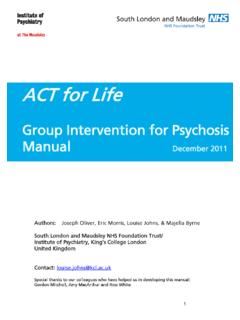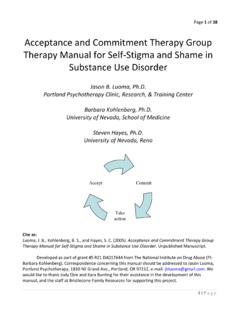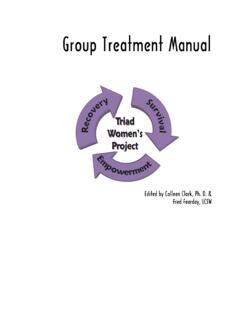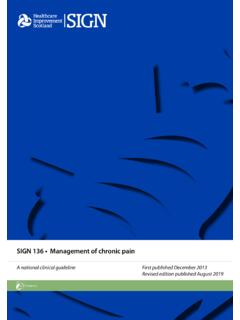Transcription of Acceptance and commitment therapy in groups
1 Acceptance and commitment therapy in groupsEric Morris, @morrisericResources: in groups : recent experienceRunning and evaluating groups using these protocols: ACT for Life / Recovery ( ) The Mindful and Effective Employee ( ) ACT on Social Anxiety ( ) group ACT for psychosisAdvertised to the community as workshops to support personal recovery. Designed to reach those people who would not engage in individual psychological therapy . Co-led with peer facilitators (ACT for Recovery) ACT: a good fit for people from minority backgrounds. ACT in groups -rationale Many ACT metaphors are interactive and benefit from more people ( Passengers on the Bus) Listening to reactions and responses of others can increase learning Often easier to notice others getting hooked (fused) ACT in groups rationale 2 Making commitments in social context likely to strengthen action Observing others being present and willing can promote these processes in self and can be a powerful experience Reduce stigma and increase self compassion I m not the only one!
2 What are we trying to do?Promote flexible sensitivity to context help participantsto increase contact with a variety of influences, that: increase the chances of effective behaviours being chosenWhat are we trying to do?Promote functional coherence help participantsto make choices based on wholeness and effectiveness helpparticipants to integrate experiences flexibly; actions about meaningful livingSimpler ACTsWays of presenting the model to participants without getting caught up in jargon, being overly-technical etc. MINDFULNESSVALUES-BASED ACTION Present moment awareness trainingUntangling from difficult thought and emotion Finding your resilient sense of selfClarifying your most valued life directionsUsing values as a guide to goals and daily behaviour From: Flaxman, 2011 SAFETY MODES afety behavioursFocus on Social DangerResisting anxious feelingsBuying into anxious thoughtsVITAL ACTION MODE Being fully present in social situations Bring Acceptance and compassion to difficult feelings Gaining distance from worries Getting in touch with your values and goalsLouise Hayes & Joseph Ciarrochi, 2015 Tips in presenting ACT Show, rather than Tell It s the group experience that matters Always be shaping Do participants need to know technical terms to become more psychologically flexible?
3 And when you see greater psychological get out of the participants wayGroup Interactions Forming Storming Norming Performing (Tuckman, 1965) group formation through a common purpose (highlighted by facilitators), sharing, participating in the group cultureGroup cohesion fostered by sharing of experiences and values-based actions as common goals. Connection strengthened by going through similar experiences (such as exercises) and language ( , my passengers )Facilitators progressively shape a culture of psychological flexibility Highlight common struggles Reinforce noticing, openness, sharing vulnerability Make the group the processTending to the budding of psychological flexibility Working with Participants MaterialFind a balance between being respectful and keeping it light when using participant thoughts. Use your own, truthful material first Always practice kindness and non-judgment Emphasize the ubiquitous nature of negative thoughts and distressing emotions (we are all swimming in the same verbal soup) Give choices when it comes to protecting participant material Keep groups small Self-disclosure with skillSharing personal experiences as a means of furthering the group connecting at an authentic, emotional level (vulnerability) and ask: who is this for?
4 Two ways: Share what you are currently experiencing Share examples from your personal lifeThe Values LensIdentifying values Be prepared for participants not to know or struggle with identifying values If this workshop could be about something important just for you If this group could really be about doing something important, if magic could happen, and you leave the group and just do this what would it be? Think of times when you felt open, vital or engaged Acknowledge distress associated with contacting valuesFlexible mindfulness exercises Generally keep it simple Avoid long eyes-shut exercises initially Creatively use mindfulness Forms of mindfulness: sitting down, moving around, short periods, different senses Mindful eating Mindful walking notice something Beautiful, Interesting, Funny Be clear that there is no right way Reinforce all sorts of noticing Mindful enquiry An ad-libbing challenge!
5 General principles: We reinforce all sorts of noticing Content is less interesting than the process Promote that being in the present is something we do Practice in all sorts of ways is how noticing now becomes an option As the group goes on, take chances with letting the participants strengthen each other Take chances with asking less vocal participants about their experiences Using Open/ Aware/ Active Skills Noticing skills are used throughout the group . Capitaliseon opportunities for modeling:Part. I felt really bad during the mindfulness exercise. All the anxieties of the week just flooded me. Trainer. As you say this I notice my tricky mind rushing in, urging me to do something to help with those anxieties. Quickly, get rid of those passengers . group ProcessA group is ideal for noticing others getting hooked in example: I guess I m not mindfulness material.
6 I just can t sit still-It s similar with other things, I am very fidgety. Yes, I had a similar set of passengers. I kept thinking I can t just sit here doing nothing for half an hour I did it though, turns out I could still do the exercises a few times. These folk are working really. Introducingmetaphors Telling the story Using cartoons, images, videos Physicalisingand acting out the metaphorAn ACT metaphor is like a As a central scaffold for the group Development of a micro-culture By providing a common language Repetition and multiple formats increases fluency group process supports functional coherence Multiple examples Differing experiences can be functionally similarAvoid metaphor abuse!Avoiding metaphor abuse You can load sessions with too many metaphors! In our experience, better to use one or two each time Focus on what the session is in the service of Experiential process of change rather than sense-making ACT is about promoting values-driven behavioursrather than working things out CLASSIC ACT EXERCISESAs group ExperiencesShow rather than Tell Careful not to get entangled in over-explaining.
7 Involve your body in interventions to avoid getting entrapped in as pieces of paper Promoting distance/ contact/ observing by writing/ drawing out experiences on paper And trying various responses pushing away, eyes-on, in your lap, held by another The Post-It note is your Friend Small usually doesn t overwhelm to write or draw on Easy to carry Encourages brevity May have playful quality Can stick it on people! PASSENGERS ON THE BUSS ensationsMemoriesThoughtsFeelingsVoicesO pen up Noticing passengers, what they say, how they look, when they get rowdy, demanding, commanding Noticing workability of struggling with passengers Adding in alternative ways of being with passengers Making space Inviting along for the ride Noticing without necessarily engaging with Noticing opportunities to base actions on values, rather than what passengers wantPassengers -animationActing out Tug of WarTug of WarMind VolleyballCommitted actionOpen and Aware while ActiveHelp the participants to notice their actual experiences (sensations, thoughts, emotions) while engaged in values (overarching goals & qualities of action) Encourage participants to observe and describe experiences with performing actions.
8 Especially those associated with satisfaction in engaging in a meaningful direction this may increase intrinsic reinforcement and help engagementMethods: break into small groups : use participantdescription, slowing down and appreciating, imaginal exercises, facilitatorsnoticing shifts in posture in session etc. Further resources Passengers Animation How to run Passengers as a group Exercise



